Dhoraji Fort

Information on Dhoraji Fort (Rajkot, Gujarat) - History & Architecture
The structure i.e. Dhoraji Fort is positioned in Rajkot in the Indian state of Gujarat. The place is located in the Dhoraji which is a small city in Gujarat. The fort has a long history of more than 200 years associated with it. The fort is well known for its historical and architectural beauty.
Dhoraji Fort Architecture
Architecturally, the fort is one of the most beautiful in the entire Gujarat. Though made in the absence of any technological equipment during the 17th century period, the fort still holds numerous features which are comparable to the present modern day infrastructure. There were several huge bastions positioned within the fort that can still be seen in the present day. The four huge gates, which were also the entrance to the fort, lies in the east, west, north and south direction. Notably, Kathiawadi Darwaja, Porbandar Gate, Halar Gate and Junagadh Gate are at the east, west, north and south end respectively. There is a beautiful gate within the fort which has elephant statue poses in front of it and is known as jharokha. The main entrance directly leads to the courtyard of the fort. The entire fort has been ornamented and designed with sculptures of different musicians, images of animals such as lions and designs of kangaroos among others. The architectural prominence of the fort can be comprehended from the fact that is has been designed like a jewel box which holds resemblance with the architectural design of the Navlakha Places located in Gondal.
Dhoraji Fort History
Historically, the fort has certain crucial background which must be mentioned more apparently. It was during the 18th century that the fort was actually built. The fort which is located at the banks of the river Safura, the completion of the fort was seen in the year 18th century. In the early period of this particular century, the place i.e. Dhoraji was overtaken by the Kumbhoj II who was the ruler of the Junagadh State during that time. However, the real planning of the fort was come under the guidance of Sir Bhagwatsinhji who was the noble ruler of the Darbargadh. The planning was to establish the entire town and complete it for use by the early period of the 19th century. His approach as well as input towards ensuring proper regularizing of the entire town could be hardly negligible. However, it was claimed by many that the initial completion of the fort which was later ruined was seen in the year 1755 AD. The fort is quite massive in terms of the area in which it has been made. Records as well as present day scenario, suggests that there were more than 4 huge gates within the fort in addition to the three small ones. The names of the small gates were collectively known as the Baris.
Dhoraji Fort Tourism Importance
With regard to tourism, the place is very much adored by the visitors owing to its architectural and historical importance. Notably, the fort has been designed in the form of a jewel box which is one of its kinds that can be found in this particular state. Moreover, the place is also quite easily reachable by rail, road and airways which are again an encouraging factor for the tourists that visit the place from different corners of the country. Again the Temple of Goddess Ashapura which is a nearby attraction of the fort will also influence the tourists to visit the place comprehensively.
- Andaman Nicobar Monuments
- Andhra Pradesh Monuments
- Assam Monuments
- Bihar Monuments
- Chhattisgarh Monuments
- New Delhi Monuments
- Goa Monuments
- Gujarat Monuments
- Haryana Monuments
- Himachal Pradesh Monuments
- Jammu and Kashmir Monuments
- Karnataka Monuments
- Kerala Monuments
- Madhya Pradesh Monuments
- Maharashtra Monuments
- Odisha Monuments
- Punjab Monuments
- Rajasthan Monuments
- Tamil Nadu Monuments
- Telangana Monuments
- Uttar Pradesh Monuments
- West Bengal Monuments